Introduction to Data structure and algorithm.pptx
- 1. 1
- 2. The end of this session, You will be able to, Explain what is Data Structure(DS) and important of DS. Define the Primitives operation on DS. Differentiate the classification of DS. Explain the Time Complexity of an algorithm. Calculate the Time Complexity of a given algorithm. 2
- 3. A computer is a programmable data processor that accepts input and instructions to process the input (program) and generates the required output. 3
- 5. Data are values or a set of values Data item refers to single unit of values Group item : Data item that can be subdivided into sub item. Ex Name : First Name, Middle initial and Last Name Elementary item: Data item that can not be sub divided into sub item Ex :NI card number / Bank Pass Book Number is treated as single item 5
- 6. Collection of data are frequently organized into a hierarchy of fields, records and files 6
- 7. Entity : Something that has certain attributes or properties which may be assigned values, values may be numeric or non-numeric. Ex: The employee of an organization Attributes Values Name John Age 33 Sex M Employee Code 13472 7
- 8. Entity with similar attributes ( e.g all employees of an organization) form an entity set. Each attribute of an entity set has a range of values [ the set of possible values that could be assigned to the particular attribute]. Information: Data with given attribute or processed data. 8
- 9. Field is a single elementary unit of information representing an attribute of an entity. Record is the collection of field values of a given entity. File is the collection of records of the entities in a given entity set. 9
- 10. Name Age Sex Roll Number Branch A 17 M 109cs0132 CSE B 18 M 109ee1234 EE C 19 F 109ce0012 CE D 20 F 108mm0132 MM 10
- 11. Data type refers to the kind of data a variable may store. Whenever we try to implement any algorithm in some programming language, we need variables. A variable may have any value as per the facilities provided by that language. int, float, char, double, long double, etc. Data type is a term that specifies the type of data that a variable may hold in the programming language. 11
- 12. In general, languages have their built-in data types. However, they also allow the user to define his or her own data types, called user-defined data types, using the built- in data types; for example, in the C/C++ languages, int, float, and char are built-in data types. Using these built-in data types, we can design (define) our own data types by means of structures, unions, and classes. 12
- 13. Data structure is a specialized format for organizing, processing, retrieving and storing data. The logical or mathematical model of a particular organization of data. The term data structure refers to the organization of data elements and the interrelationships among them. 13
- 14. A data structure is a set of domains D, a designated domain d ( D), a set of functions F, and a set of axioms A. The triple structure (D, F, A) denotes the data structure with the following elements: Domain (D) This is the range of values that the data may have. Functions (F) This is the set of operations for the data. We must specify a set of operations for a data structure to operate on. Axioms (A) This is a set of rules with which the different operations belonging to F can actually be implemented. 14
- 15. Abstraction allows us to organize the complexity of a task by focusing on logical properties of data and actions rather than on the implementation details. Logical properties refer to the ‘what’ and implementation details refer to the ‘how’. The abstraction is at the procedural and data level. Data abstraction is the separation of logical properties of the data from details of how the data is represented. Procedural abstraction means separation of the logical properties of action from implementation. 15
- 16. We defined a data structure as a way of organizing data that specifies 1. a set of data elements, that is, a data object. 2. a set of operations that are applied to this data object. These two sets form a mathematical construct that may be implemented using a particular programming language. 16
- 17. Data appearing in DS are processed by means of certain operation. Particular DS one chooses for a given situation depends largely on the frequency with which specific operations are performed. 17
- 18. Traversing: Accessing each record exactly once so that certain items in the record may be processed [ Also known as Visiting the record]. Searching: Finding the location of the record with a given key value, or finding the locations of all record which satisfy one or more conditions. 18
- 19. Inserting : Adding a new record to the structure. Deleting : Removing a record from the structure 19
- 20. 20
- 21. 21
- 22. The success of a software project often depends upon the choices made in the representation of the data and the choice of algorithms, and hence we need better methods to describe and process the data. 22
- 23. • Time complexity of an algorithm signifies the total time required by the program to run till its completion. • The time complexity of algorithms is most commonly expressed using the big O notation. 23
- 24. • Time Complexity is most commonly estimated by counting the number of elementary functions performed by the algorithm. • And since the algorithm's performance may vary with different types of input data, hence for an algorithm we usually use the worst-case Time complexity of an algorithm because that is the maximum time taken for any input size. 24
- 25. Using the RAM model of computation, we can count how many steps our algorithm will take on any given input instance by simply executing it on the given input. However, to really understand how good or bad an algorithm is, we must know how it works over all instances. 25
- 26. The worst-case complexity of the algorithm is the function defined by the maximum number of steps taken on any instance of size n. It represents the curve passing through the highest point of each column. The best-case complexity of the algorithm is the function defined by the minimum number of steps taken on any instance of size n. It represents the curve passing through the lowest point of each column. Finally, the average-case complexity of the algorithm is the function defined by the average number of steps taken on any instance of size n. 26
- 27. 27
- 28. statement; • Above we have a single statement. Its Time Complexity will be Constant. The running time of the statement will not change in relation to N. 28
- 29. Consider the following function: System.out.println(number); if(day = 1){ System.out.println(“Monday”); } . . 10 million lines of code } Time complexity = 10 million time constant = O(1) 29
- 30. for(i=0; i < N; i++) { statement; } The time complexity for the above algorithm will be Linear. The running time of the loop is directly proportional to N. When N doubles, so does the running time. 30
- 31. 31
- 32. MATRIX, N-BY-1 VECTOR, MULTIPLY Y = zeros(N,1); for i=1:N Y(i) = 0.0; for j=1:N Y(i) = Y(i) + A(i,j)*x(j); end end initialize space, c1N initialize “for” loop, c2N Scalar assignment, c3 initialize “for” loop, c2N (3 accesses, 1 add, 1 multiply) c4 End of loop, return/exit, c5 End of loop, return/exit, c5 Total = c1N+c2N+N(c3+c2N+N(c4+c5)+c5) = (c2+c4+c5)N2 + (c1+c2+c3+c5)N = c6N2 + c7N N times N times Time complexity of an algorithm[O(N2)] 32
- 33. 33
- 34. fun(int n) { int i,j; for(i=n; i<1; i=i/2) { j = n; while(j>1) { j=j/2; } } } TIME COMPLEXITY OF AN ALGORITHM[O(LOG2(N)] i = n n/2 n/22 n/23 n/2k n< 2k log n < log 2k log2 n < log2 2k 34
- 35. for(int n) { int I,j: for(i=1; i<n; i=i*i) { i++; j=n; while(j>0) { j=j/3; } } } 35
- 36. fun(int n) { int I,j,k; for(i=1; i<n; i++) { for(j=1; j<n; j=j+2) { for(k=10; k>0; k=k-3) { printf(“Hello”); } } } } 36
- 37. 37







![Entity with similar attributes ( e.g all employees of an
organization) form an entity set.
Each attribute of an entity set has a range of values [ the
set of possible values that could be assigned to the
particular attribute].
Information: Data with given attribute or processed data.
8](https://image.slidesharecdn.com/introductiontodatastructureandalgorithm-240214144940-de2904ed/85/Introduction-to-Data-structure-and-algorithm-pptx-8-320.jpg)



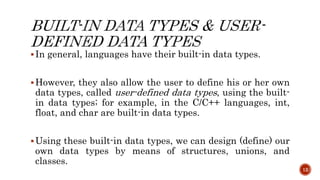


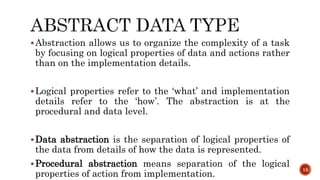
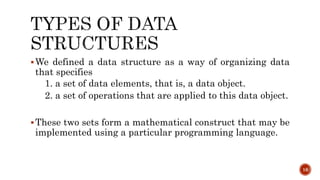
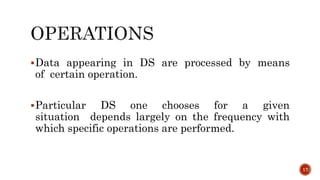
![Traversing: Accessing each record exactly once
so that certain items in the record may be
processed [ Also known as Visiting the record].
Searching: Finding the location of the record
with a given key value, or finding the locations of
all record which satisfy one or more conditions.
18](https://image.slidesharecdn.com/introductiontodatastructureandalgorithm-240214144940-de2904ed/85/Introduction-to-Data-structure-and-algorithm-pptx-18-320.jpg)


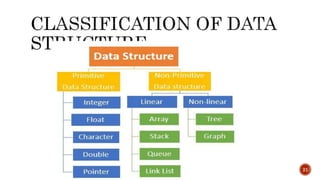





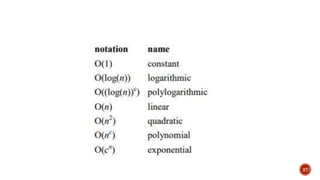
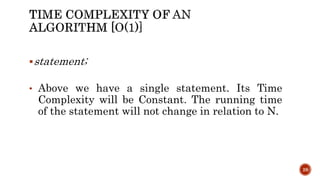



![MATRIX, N-BY-1
VECTOR, MULTIPLY
Y = zeros(N,1);
for i=1:N
Y(i) = 0.0;
for j=1:N
Y(i) = Y(i) + A(i,j)*x(j);
end
end
initialize space, c1N
initialize “for” loop, c2N
Scalar assignment, c3
initialize “for” loop, c2N
(3 accesses, 1 add, 1 multiply)
c4
End of loop, return/exit, c5
End of loop, return/exit, c5
Total = c1N+c2N+N(c3+c2N+N(c4+c5)+c5)
= (c2+c4+c5)N2 + (c1+c2+c3+c5)N
= c6N2 + c7N
N
times
N
times
Time complexity of an algorithm[O(N2)]
32](https://image.slidesharecdn.com/introductiontodatastructureandalgorithm-240214144940-de2904ed/85/Introduction-to-Data-structure-and-algorithm-pptx-32-320.jpg)

![fun(int n)
{
int i,j;
for(i=n; i<1; i=i/2)
{
j = n;
while(j>1)
{
j=j/2;
}
}
}
TIME COMPLEXITY OF AN ALGORITHM[O(LOG2(N)]
i = n n/2 n/22 n/23 n/2k
n< 2k
log n < log 2k
log2
n < log2
2k
34](https://image.slidesharecdn.com/introductiontodatastructureandalgorithm-240214144940-de2904ed/85/Introduction-to-Data-structure-and-algorithm-pptx-34-320.jpg)


